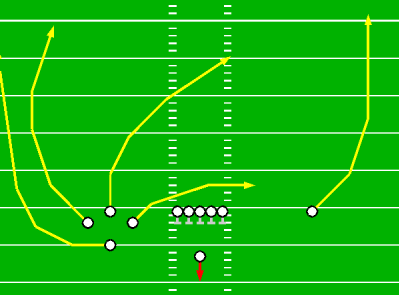Description
Sometimes when I start to design a play I decide to break away from traditional techniques (both mainstream and traditional for me) and look at whole new patterns. For most passing plays I start with one or two primary routes and built support around this foundation. When I really want to try something new I throw this method out and build a set of routes around a theme that seems more intended for pleasing aesthetics rather than effective offense. Often this approach leads only to dead ends and I end up scrapping the play and starting over. Once in a while though, I end up with something really good. Nova is one such play designed in this way. This play, Chariot, is another.

The resemblance is obvious; Nova had a big influence on the design of Chariot. Both share the same type of flowing routes with no sharp angles to be seen. In isolation most such smoothly flowing routes can be defended easily, but many working together can create a powerful force. In the case of the four bunch receivers each route flows through the trail of the route counter-clockwise to it (excepting the inside flanker drag route) while simultaneously the routes spread apart from each other. Each route bends towards the quarterback, constantly chipping away at the nearest defender's angle of attack on the potential pass to be thrown. The right split end runs an outside fade route like those in Antigravity, pulling the defense outward and forcing the cornerback to turn his back to the play.
Plays like Chariot that have this artistic feel to them are some my favorites because they defy being broken down mechanically, as is done to explain most plays. I'll give it my best shot regardless, but to really make the most of Chariot's potential you have to execute it with an almost intuitive feel. Not just making read one, read two, read three, etc., but sensing the movement of the receivers and defenders as a whole and feeling where the openings will occur. Practice is the best guide I can give you.
Player Assignments
| Position | Action |
|---|---|
| O-Line | Pass Block |
| QB | Dropback 2yd |
| Left Outside Flanker | N2W2-N3W1-N2-N3E1 (open) |
| Left SE | N2-N2E1-N2E2-N2E3 (open) |
| Left Inside Flanker | N1E1-N1E3-E2 (open) |
| Left Rear Flanker | W2-N1W2-N2W1-N7W1 (open) |
| Right SE | N2E2-N3E1-N5 (open) |
See the Madden Playbook Guide for a description of these symbols.
Read Progression
- Inside flanker drag (quick)
- Left rear flanker out
- Right SE fade post in seam
- Right SE fade
- Left outside flanker fade
- Right SE fade post deep
- Right inside flanker drag late across middle
- Right rear flanker fade deep along sidelines
Now that I've just said that Chariot defies mechanical explanation, I'm going to do my best to break it down anyway. The first few reads are quite fast so a lot of practice is in order to get them all down. Look sharply to the left for a quick throw to the drag route, then farther left to the out pattern underneath the front bunched receivers. Next, you may be able to hit the left SE just a few yards upfield before the major curve in his route. Look once to the right side for the SE fade, then back to the left for the outside flanker fade. Next is the big money throw, the fade post route over the deep middle. If you still have the ball you may want to buy some time with your feet; scrambling to the right will let you throw the flanker drag after he gets past the linebacker. Finally, heave the ball long down the left sideline to the secondary rear flanker fade. This may be a desperation pass at this point, but at least it should end up close to the sideline where it will be harder for a DB to make a good play on the ball.
Incidentally, while many of my plays rely on combinations of routes and sharp timing to defeat man coverage and therefore don't fare so well against bump and run press coverage, Chariot is not one of these plays. In fact, Chariot may be at its best against the bump and run. The outside flanker is the most likely recipient of a bump on the left side, and this makes for a perfect screen for the quick out pattern underneath. The sideline fade patterns on either side also make for deadly targets provided the QB can hold the ball long enough to throw after the press is broken. In some cases the two left fade routes will be running almost side by side because the rear flanker will have had a chance to catch up to the outside flanker who was bumped. This may allow the leading outside flanker to throw a nice downfield block for the trailing receiver.
Analysis
Pros:
- One of my best passing plays versus press coverage
- Fade post route makes Chariot one of my best plays for attacking the deep middle
- Smooth routes which can each be thrown at any time make for good weapons against a blitz
Cons:
- Fairly difficult play to learn, very difficult to master
- Hard to complete deep routes against deep zone coverage
- Quick out underneath bunch can be difficult to complete in bounds when close to the left sideline
- Dime and Quarter defenses usually have the single linebacker drop into a shallow zone, requiring either a very quick or fairly late throw to complete the drag route safely
Contact Arkaein with any comments or questions regarding the Monstrous Madden Playbook.